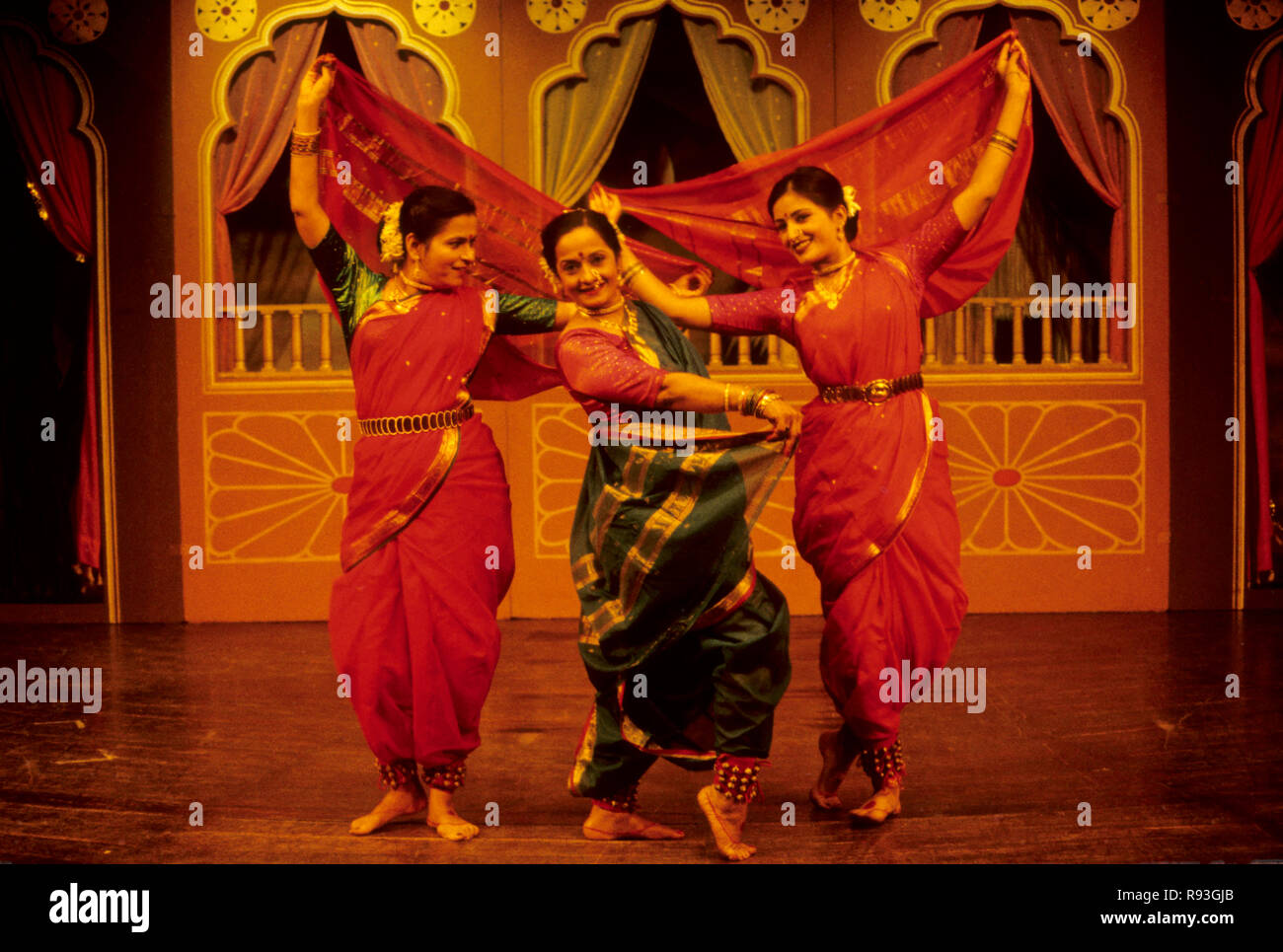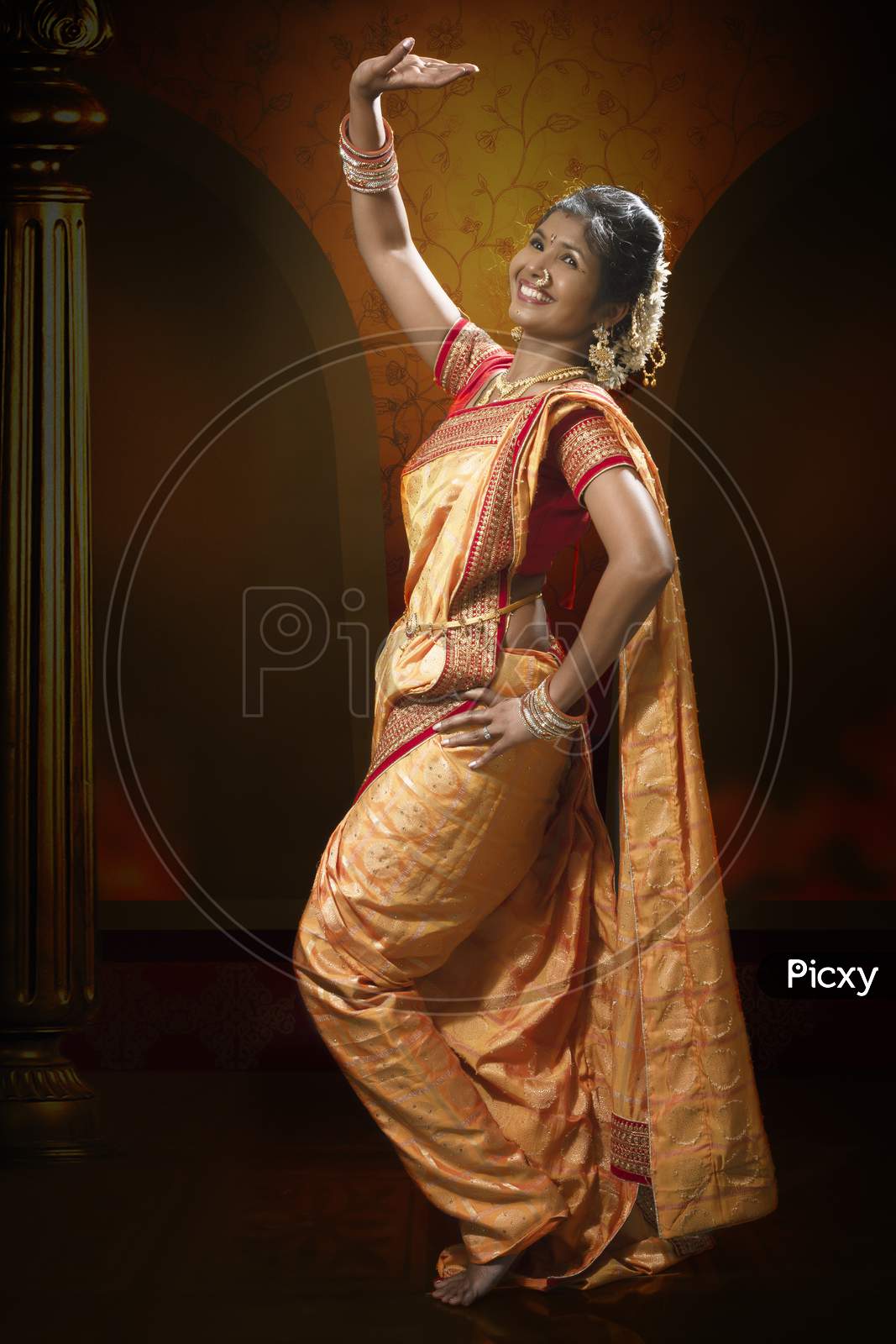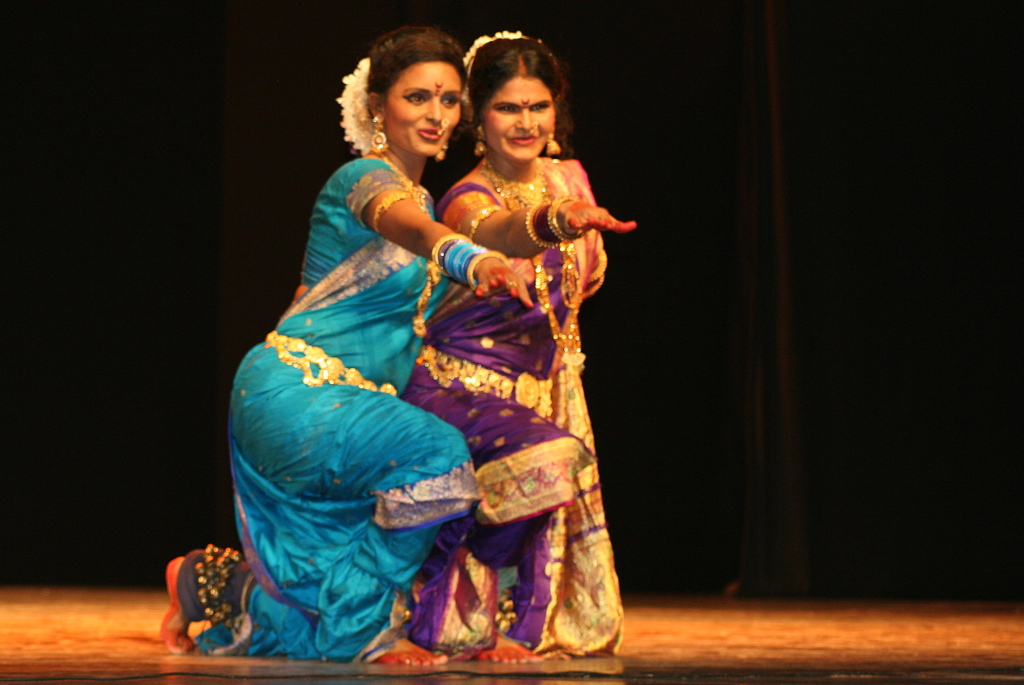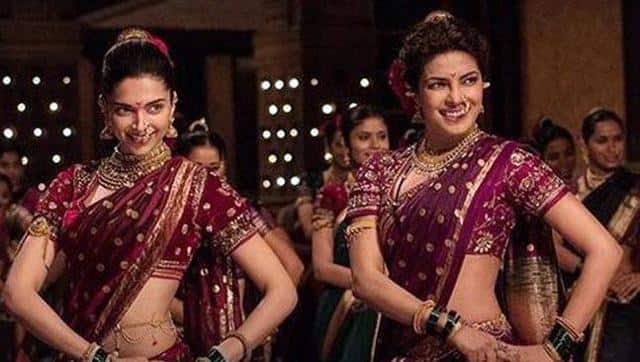ॐ श्री गुरुभ्यो नमः ॐ श्री शिवानन्दाय नमः ॐ श्री चिदानन्दाय नमः ॐ श्री दुर्गायै नमः
‘The Cultural Heritage of India’ Blog in Different Global Languages
Source of all Images in this Blog-post : Google Images : ‘Google Image Search’ will reveal the multiple sources of every single image shared in this Blog. For more details, kindly see the ‘Disclaimer‘
Buy Lavani Nauwari Saree online by clicking here
Buy Dance Jewellery Online on Amazon India
Lavani is a combination of traditional song and dance which is performed to the dholki drum. Noted for its powerful rhythm and eroticism, Lavani has contributed to the development of Marathi folk theatre.
In Maharashtra and southern Madhya Pradesh, it is performed by women wearing nine-yard-long saris. The songs are sung at a quick tempo.
*********************************
Shopping : Buy Lavani Nauwari Sarees online by clicking on the below images
Shopping : Buy Lavani Nauwari Sarees online by clicking on the above images
**********************
Lavani :
Lavani is a combination of song and dance that is most commonly associated with the state of Maharashtra as well as the surrounding areas in the Konkan or Coastal Region.
The word ‘Lavani’ is derived from the word Lavanya, which means ‘beauty’. Lavani aims to take various aspects of social life such as politics, religion, romance, etc. and present them in an entertaining form.
Buy Dance Jewellery Online on Amazon India

Background :
The Lavani dance originated as a form of morale booster for warring troops during the 18th and the 19th century when the state of Maharashtra was embroiled in conflict and turmoil.
The dance form reached the peak of its popularity during the rule of the Peshawari Dynasty that was seated in Pune during which it was given support by the ruling elite.
The Lavani dance is generally performed by Dhangars or shepherds living in the Sholapur district of Maharashtra. They are inspired by nature and the dance form contains tales of the birth of Biruba, their deity.
The more commonly performed forms of the Lavani dance are concentrated in Maharashtra and are not restricted to the Dhangar community.
The Performance :
It is performed by women who dance to the beats of a Dholak, which is an Indian drum.
It isn’t uncommon for the Dholak to be accompanied by other instruments like a cymbal called the Manjeera, a string instrument called a Tuntuni, a Daf which is quite similar to a tambourine but has a single leather surface, along with a harmonium.
Buy Dance Jewellery Online on Amazon India

The tempo of the music and the dance is quite fast, and the music is supported by the performers themselves who wear ankle bells called the Ghungroo. The quick tempo helps pump up the dances as well as the crowd and a Lavani performance is generally quite vivacious and energetic.
A Lavani performance can be broadly categorized into two parts. The Nirguni Lavani, which deals with philosophy and Shringari Lavani which deals with sensuality.
Shrinagri Lavani is more popular than Nirguni Lavani and is performed in theaters as well as Bollywood movies. Shringari Lavani deals with a multitude of genres, with the love between a man and a woman being the most prominent.
Themes such as the sexual union between husband and wife, adultery, menstruation as well as childbirth are common themes that are enacted. Long performances of the Lavani depict various situations such as the separation of a husband and wife or the passionate endeavors of soldiers.
Style and variety :
The quintessential part of each performance is the saree. The saree worn by the performers is longer than the usual and is called a nauvari, which is wrapped around in a Kashta drape.
Buy Jewellery for Lavani dance

A nauvari Saree measures 9 yards in length. The unique Kashta drape is not only much more comfortable as compared to other forms of draping a Saree, but allows for a greater movement.
Since the nauvari saree generally goes hand-in-hand with the kashta drape, and the dance requires fast-paced movement, traditional cotton Sarees are the ideal choice.
Although it can be argued that it is easier to manipulate lighter materials like chiffon into the kashta drape, cotton is better because it will prevent the Saree from riding up. Moreover, cotton is a cool and strong fabric that absorbs sweat easily and is less likely to tear or get damaged.

Besides the Saree, the performers also tie their hair back in bun called a Juda or Ambada. The performers may also choose to wear a Gajra which is a flower garland for the hair. Performers also wear heavy jewelry that includes necklace, earrings, a nose ring called a nath, and bangles.

They also wear a Kamarpatta which is a belt at the waist. On their feet, performers wear Payal or Ghungroo which not only looks beautiful, but can also be considered a musical instrument in its own right. Lavani performers also put a large red bindi on their forehead.
Perception of the Dance Form :
Its popularity has reduced in the recent times and most people consider it passé. Due to the sensuous nature of the dance form as well as its depiction in mainstream Bollywood films, the performers of Lavani are stereotyped and discriminated against.
Buy Lavani Nauwari Saree online by clicking here

Currently, 40 medium sized troupes performing Lavani and about 600 small troupes exist in the state of Maharashtra alone.
Interesting Facts :
A performance in front of a large audience is called Padhachi Lavani. It is performed for a small select audience is called Baithakichi Lavani and is performed by a solitary woman who is sitting down.
A traditional Lavani drama goes on through the night and at the end of one, a replica of the Manmathas mount is burnt.

There are males who perform this dance form. These male dancers are called Nats or Kinnars. One other dance form associated with Lavani is known as the Tamasha.
Lavani, the most popular dance form of Maharashtra derives its name from Lavanya, which is translated as beauty.
It is performed by beautiful women wearing nine yards sarees and dancing to the beats of a drum-like instrument called dholak. The movements are gyrating and spiral and involve intricate leg and hip movements.
The Lavani is a traditional dance form which earlier depicted the life of the ordinary people, society, overall. It later went on to be performed for the tired soldiers of the Maratha battles and further on came to be misused for the entertainment of influential people.
The disrepute gained in this process maligned the dance form for a few years but it was eventually revived by several great poets and reformers and its lost glory was thereby reinstated.
Today, Lavani is performed in the Baithi (sitting position) form also, in addition to the traditional standing position. To see Video of Top 8 Lavani songs.
Lavani is a genre of music popular in Maharashtra, India. Lavani is a combination of traditional song and dance, which particularly performed to the beats of Dholki, a percussion instrument.
Lavani is noted for its powerful rhythm. Lavani has contributed substantially to the development of Marathi folk theatre.
In Maharashtra and southern Madhya Pradesh, it is performed by the female performers wearing nine-yard long Sarees. The songs are sung in a quick tempo.
Etymology :
According to a tradition, the word Lavani is derived from the word Lavanya which means beauty. According to another tradition, it is derived from Marathi Lavene.
History and Genres :
Traditionally, this genre of folk dance deals with different and varied subject matters such as society, religion and politics. The songs in ‘Lavani’ are mostly erotic in sentiment and the dialogues tend to be pungent in socio-political satire.

Originally, it was used as a form of entertainment and morale booster to the tired soldiers. Lavani Songs, which are sung along with dance, are usually naughty and erotic in nature.

It is believed their origin is in the Prakrit Gathas collected by Hala. The Nirguni Lavani (philosophical) and the Shringari Lavani (sensual) are the two types. The devotional music of the Nirguni cult is popular all over Malwa.
Lavani developed into two distinct performances, namely Phadachi Lavani and Baithakichi Lavani.
Buy Lavani Nauwari Saree online by clicking here
Buy Dance Jewellery Online on Amazon India

The Lavani sung and enacted in a public performance before a large audience in a theatrical atmosphere is called Phadachi Lavani.
And, when the Lavani is sung in a closed chamber for a private and select audience by a girl sitting before the audience, it came to be known as Baithakichi Lavani.
Lavani Dress
The ladies that perform lavani wear a long Sari length around 9 yards. They form a bun (Juda in Hindi or Ambada in Marathi) with their hair.
Lavani Saree for kids on Amazon India
They wear heavy jewellery that includes necklace, earrings, Payal, Kamarpatta (a belt at the waist), bangles etc. They usually put a large Bindi of dark red color on their forehead.
The sari they wear is called Nauvari. The Sari is wrapped and is more comfortable as compared to other Sari styles.
There are also men that dance in Lavni along with the ladies. They are the called nat (male dancer) usually the Kinnars. These men dance in support with the lead dancer.
Although the beginnings of Lavani can be traced back to the 1560s, it came into prominence during the later days of the Peshwa rule.
Several celebrated Marathi Shahir poet-singers, which include Parasharam (1754-1844), Ram Joshi (1762–1812), Anant Fandi (1744-1819), Honaji Bala (1754-1844), Prabhakar (1769-1843), Saganbhau and Lok Shahir Annabhau Sathe (1 August 1920 – 18 July 1969) has contributed significantly for the development of this genre of music.
Lokshahir Bashir Momin Kavathekar is the popular present day Shaheer/ Poet of Lavani whose compositions are presented on stage by Surekha Punekar, Sandhya Mane, Roshan Satarkar and many Tamasha Troupes since the early 1980s.
Honaji Bala introduced tabla in place of the traditional Dholki. He also developed the Baithakichi Lavani, a subgenre, which is presented by the singer in the seated position.
Satyabhamabai Pandharpurkar and Yamunabai Waikar are the popular present day exponents of Lavani.
Shringar Lavani is mostly sung and danced on the stage by a female and written by male.
Vithabai Narayangaonkar, Kantabai Satarkar, Surekha Punekar,Managala Bansode, Sandhya Mane, Roshan Satarkar are well known artiste presenting Lavani on stage.
Lavani can also be termed as a romantic song sung by lady who is waiting for her lover to accept her, who longs for his love. Many Lavani dancers are from some castes of Maharashtra like Mahar Kolhati, and Matang.
Marathi films played an important role in making the Lavani genre accessible to masses. Movies such as Pinjara and Natarang not only attempted to blend traditional music with social messages but also helped portray Lavani world in positive light.

















